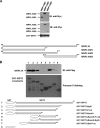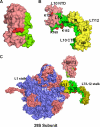NAD+-dependent deacetylase SIRT3 regulates mitochondrial protein synthesis by deacetylation of the ribosomal protein MRPL10
- PMID: 20042612
- PMCID: PMC2844190
- DOI: 10.1074/jbc.M109.053421
NAD+-dependent deacetylase SIRT3 regulates mitochondrial protein synthesis by deacetylation of the ribosomal protein MRPL10
Abstract
A member of the sirtuin family of NAD(+)-dependent deacetylases, SIRT3, is located in mammalian mitochondria and is important for regulation of mitochondrial metabolism, cell survival, and longevity. In this study, MRPL10 (mitochondrial ribosomal protein L10) was identified as the major acetylated protein in the mitochondrial ribosome. Ribosome-associated SIRT3 was found to be responsible for deacetylation of MRPL10 in an NAD(+)-dependent manner. We mapped the acetylated Lys residues by tandem mass spectrometry and determined the role of these residues in acetylation of MRPL10 by site-directed mutagenesis. Furthermore, we observed that the increased acetylation of MRPL10 led to an increase in translational activity of mitochondrial ribosomes in Sirt3(-/-) mice. In a similar manner, ectopic expression and knockdown of SIRT3 in C2C12 cells resulted in the suppression and enhancement of mitochondrial protein synthesis, respectively. Our findings constitute the first evidence for the regulation of mitochondrial protein synthesis by the reversible acetylation of the mitochondrial ribosome and characterize MRPL10 as a novel substrate of the NAD(+)-dependent deacetylase, SIRT3.
Figures







Similar articles
-
Regulation of succinate dehydrogenase activity by SIRT3 in mammalian mitochondria.Biochemistry. 2010 Jan 19;49(2):304-11. doi: 10.1021/bi901627u. Biochemistry. 2010. PMID: 20000467 Free PMC article.
-
SIRT3 substrate specificity determined by peptide arrays and machine learning.ACS Chem Biol. 2011 Feb 18;6(2):146-57. doi: 10.1021/cb100218d. Epub 2010 Nov 1. ACS Chem Biol. 2011. PMID: 20945913 Free PMC article.
-
Succinate dehydrogenase is a direct target of sirtuin 3 deacetylase activity.PLoS One. 2011;6(8):e23295. doi: 10.1371/journal.pone.0023295. Epub 2011 Aug 17. PLoS One. 2011. PMID: 21858060 Free PMC article.
-
Mitochondrial protein acetylation regulates metabolism.Essays Biochem. 2012;52:23-35. doi: 10.1042/bse0520023. Essays Biochem. 2012. PMID: 22708561 Free PMC article. Review.
-
Mitochondrial sirtuins.Biochim Biophys Acta. 2010 Aug;1804(8):1645-51. doi: 10.1016/j.bbapap.2009.12.021. Epub 2010 Jan 7. Biochim Biophys Acta. 2010. PMID: 20060508 Review.
Cited by
-
Sirtuins Function as the Modulators in Aging-related Diseases in Common or Respectively.Chin Med J (Engl). 2015 Jun 20;128(12):1671-8. doi: 10.4103/0366-6999.158375. Chin Med J (Engl). 2015. PMID: 26063372 Free PMC article. Review. No abstract available.
-
Oxidative stress as a key modulator of cell fate decision in osteoarthritis and osteoporosis: a narrative review.Cell Mol Biol Lett. 2023 Sep 30;28(1):76. doi: 10.1186/s11658-023-00489-y. Cell Mol Biol Lett. 2023. PMID: 37777764 Free PMC article. Review.
-
SIRT3: A Central Regulator of Mitochondrial Adaptation in Health and Disease.Genes Cancer. 2013 Mar;4(3-4):118-24. doi: 10.1177/1947601913476949. Genes Cancer. 2013. PMID: 24020003 Free PMC article.
-
Interplay Between the Circadian Clock and Sirtuins.Int J Mol Sci. 2024 Oct 25;25(21):11469. doi: 10.3390/ijms252111469. Int J Mol Sci. 2024. PMID: 39519022 Free PMC article. Review.
-
Murine Sirt3 protein isoforms have variable half-lives.Gene. 2011 Nov 15;488(1-2):46-51. doi: 10.1016/j.gene.2011.07.029. Epub 2011 Aug 5. Gene. 2011. PMID: 21840382 Free PMC article.
References
-
- Kim S. C., Sprung R., Chen Y., Xu Y., Ball H., Pei J., Cheng T., Kho Y., Xiao H., Xiao L., Grishin N. V., White M., Yang X. J., Zhao Y. (2006) Mol. Cell 23, 607–618 - PubMed
-
- Dinardo M. M., Musicco C., Fracasso F., Milella F., Gadaleta M. N., Gadaleta G., Cantatore P. (2003) Biochem. Biophys. Res. Commun. 301, 187–191 - PubMed
Publication types
MeSH terms
Substances
Grants and funding
LinkOut - more resources
Full Text Sources
Other Literature Sources
Molecular Biology Databases

